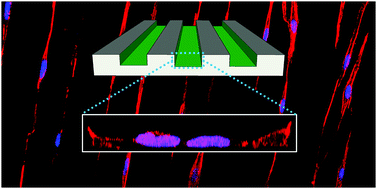Quasi-3D morphology and modulation of focal adhesions of human adult stem cells through combinatorial concave elastomeric surfaces with varied stiffness†
Abstract
In vivo cell niches are complex architectures that provide a wide range of biochemical and mechanical stimuli to control cell behavior and fate. With the aim to provide in vitro microenvironments mimicking physiological niches, microstructured substrates have been exploited to support cell adhesion and to control cell shape as well as three dimensional morphology. At variance with previous methods, we propose a simple and rapid protein subtractive soft lithographic method to obtain microstructured polydimethylsiloxane substrates for studying stem cell adhesion and growth. The shape of adult renal stem cells and nuclei is found to depend predominantly on micropatterning of elastomeric surfaces and only weakly on the substrate mechanical properties. Differently, focal adhesions in their shape and density but not in their alignment mainly depend on the elastomer stiffness almost regardless of microscale topography. Local surface topography with concave microgeometry enhancing adhesion drives stem cells in a quasi-three dimensional configuration where stiffness might significantly steer mechanosensing as highlighted by focal adhesion properties.



 Please wait while we load your content...
Please wait while we load your content...